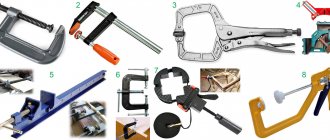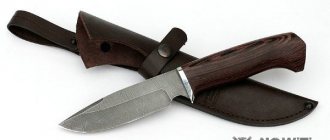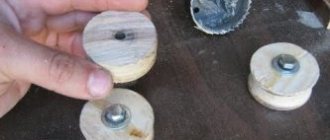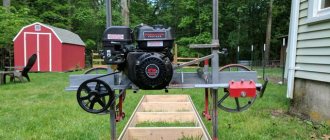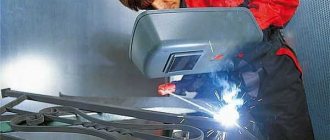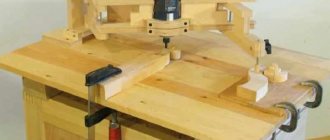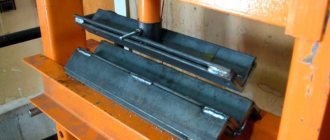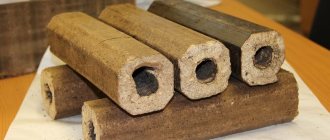Craftsmen are drinking. Excuse me, they are having a intimate conversation. For one, instead of the sacramental “Vasya, do you respect me?” “Vasya, how many hands would you like for yourself?” comes out of your mouth? He thinks about it: “How much? But who knows... Well, how much work is needed there..."
Hands, of course, to hold, press, pick up, etc. Therefore, such an auxiliary tool as temporary removable clamps of various types - clamps - is always lacking for a craftsman. There wasn’t enough at a time when these same clamps cost a penny. Nowadays they can charge more than 1000 rubles for a good clamp. Despite the fact that now even in small piece production, power tools, electric and gas welding, pressure gluing and other technologies that require reliable holding of parts during the working process are widespread. The purpose of this article is to tell the reader how to make a clamp with your own hands at home. Preferably - from scrap materials with minimal need for welding and turning work.
Note : in English, a clamp is cramp (screw), bar clamp (spring-lever) or simply clamp, similar to how a screwdriver (screw driver) is often called simply screw. A person who knows spoken English well, but is unfamiliar with the technical features (these are very different languages), hearing something like “Give me screw driver,” most likely will not understand what they want from him. Moreover, poorly educated English-language articles are most often “swallowed.” If you happen to find yourself in a similar situation, listen: “the screw” means a tool, and “a screw” means some kind of threaded hardware (screw, screw) that is twisted with it.
Varieties
The purpose of this publication is not to build something like an encyclopedia of mounting clamps - there are many types of them, and there are even more patents for new, “super-super” ones. Our task is to show which clamps are most needed in a home workshop, and how best to make a clamp without wasting a lot of material and time.
The most common types of clamps in handicraft production are shown in Fig:
- G-shaped (G-cramp; G-clamp) is the most reliable, reliable and cheapest of the general-purpose clamps. Disadvantages: it takes a long time to tighten and can turn the parts being glued if the stop hinge is of poor quality or not maintained. The latter is quite important: an adhesive layer that has not set is a good lubricant, but it is undesirable to separate and recompress the surfaces being glued together, as the strength of the dried joint decreases sharply. In addition, a regular G-clamp does not hold round parts well, so a special pipe clamp is used to secure pipes or a round profile for welding or butt soldering (see next figure). Assembled from ordinary structural steel s=(2.5-4) mm, such a welded clamp provides reliable fixation of pipes up to d(120-150)x(1.5-4) mm.
Clamp for welding and butt soldering of pipes - F-shaped (F-cramp). Quick-clamping, operates on the principle of jamming the sliding stop in the dead center position. Pressure until it is firmly secured is most often provided by a screw clamp, as in a G-shaped clamp. An even “softer” and faster clamping, but less reliable, is provided by a trigger-eccentric clamping mechanism, see below. The most versatile and widespread of the clamps. The main disadvantage is that due to vibrations and shocks during operation, it can self-unclip and release. Or, on the contrary, it jams tightly, and when wedged with a hammer blow (see below), either the clamp or the part “shoots out”. It is not suitable for adaptation to butt welding of pipes: the jaws are driven by indirect heating and the pipe joint moves apart.
- C-shaped (C-clamp, fixing tongs). A fairly narrowly specialized tool. The main purpose is to compress the parts to be glued. Simple C-clamps are made with a spring clamp. The trigger-lever clamp allows you to precisely set the clamping force.
- Angle clamps for welding linear parts (pipes, profiles) at a given angle. There is no completely established special Anglo-American term. The most commonly used are welding clamp and dead-lock clamp.
- Joiner's bench - a carpentry clamp for joining panels from boards, slats and beams, assembling units from shaped parts (for example, railings with balusters). On the trail. rice. a rail clamp is shown; There are also rack and pipe ones, see below. Please note that pipe clamps are sold under the name “pipe clamp”, and clamps for end-to-end welding/soldering of round timber should be searched for under the query “welded clamp”.
- E-shaped (E-clamp). A highly specialized tool for edging carpentry with glue. If you need to carefully glue an edge on existing valuable furniture/interior design, it is difficult to do without an E-clamp.
- O-shaped or tape, or crimp grip (loop stay, loop brace). Band clamps are most often used by virtuoso carpenters and furniture makers-restorers. If you can fetch up to $1000 or more for a well-restored antique Viennese chair, then for a slightly skewed or wobbly chair they will fetch, at best, 15-20 of the same ones. Making a frame for a large painting or photograph without a tape clamp is also not so easy.
- Lever-plunger (precision clamp). When the trigger is pressed, the plunger (pusher) with the clamping stop moves smoothly forward. The trigger is released - the plunger is fixed by a spring-loaded slide, which becomes in the dead center position. Pressing again releases the slide and further advances the plunger. A good lever-plunger clamp can securely clamp a chicken egg without damaging its shell. In a home workshop, such precision clamping is unlikely to be needed, but suddenly a good precision clamp can be obtained from a mounting gun for tubes with silicone, etc. viscous compounds. A fixed jaw can be easily installed into the opening (window) for the neck of the tube, and a movable one is mounted on the rod instead of the standard pusher. If necessary, both can be removed and the tool can be used for its intended purpose.
Order a mounting clamp with delivery and inexpensively
The main purpose of the clamp is tilting and lifting various products. But most often a clamp is used to hold something “in a vice.” Many craftsmen use it for turning work - for this you do not need to use any additional devices.
You can order a mounting clamp from our company as follows:
· Select a product in the catalog.
· Add your order to your cart.
· Please provide a contact phone number.
· Wait for a call back from the operator.
A specialist will contact you within 5-15 minutes and answer all your questions. After this, delivery will be arranged. You can also pick up your order at the company’s warehouse in Moscow. To clarify the conditions, call or write to the consultants. We will competently answer your questions and help you choose the products you need. We will be glad to see you among our company’s regular customers.
How to do which
Any of the clamps described above can be made independently in a home workshop. Carpentry clamps are made of metal - the wooden frame and jaws of the tool will not withstand the back pressure of the material of the part(s), the clamp will weaken during operation, and the clamp itself will become unusable. With welded and soldered clamps it’s already clear: only metal; wood is a flammable material.
Carpentry clamps for working with valuable wood or products are best made of wood, but you can also use metal ones with spacers made of plywood or even shingles. It is better to use wooden clamps for gluing into a layer (on thick workpieces from several thin ones), even if metal or plastic is being glued - wooden jaws provide a more uniform distribution of pressure over the plane and, accordingly, better gluing quality. Fragile parts (glass, etc.) are compressed for gluing only with wooden clamps.
What does it consist of and why is a carpentry clamp needed?
A carpenter's clamp is an auxiliary tool that provides reliable fixation of workpieces when processing them.
The standard design consists of a frame and a clamping mechanism. As you move the clamp, the spacing between frames increases or decreases. The fixing force is adjusted using a screw or lever.
Modern models are made of durable material. The tool must meet the following requirements: convenience, reliability, durability.
Lever devices operate under the influence of the handle. When it moves, a decent clamping force is created. Having immobilized the workpiece, they begin to process the part.
Scope of application:
- welding work;
- joinery;
- sharpening of blanks;
- grinding the surface of parts;
- making holes or notches, etc.
G-shaped
The frames of factory-produced G-clamps are cast. It is impossible to organize a steel foundry in a garage or barn, even in a forge on your own property. Since G-clamps, being the most “graspy” ones, are used mainly in metalworking and welding work with rather long and/or heavy parts, a homemade G-shaped clamp must be made of welded or solid metal.
Craftsmen often weld themselves clamps from sheet steel, pos. 1 in Fig.:
Homemade G-Clamps
Apparently, copying the profile of the frames of factory products, which in this case is incorrect. Profiles of cast frames of clamps are shown in pos. 2. Pay attention to the fairings and fillets (shown by arrows). Smoothing the profile is necessary to avoid the concentration of mechanical stress: they “love” corners and crevices, like bed bugs. But the weld does not work like a fillet! No, the clamp most likely will not break or bend. However, the recoil of the clamped part will move the frame a little, and it will be difficult to achieve precise fixation, and it is possible that the part may rotate when the clamp is tightened.
Homemade clamps made from channel sections are quite reliable (item 3). Disadvantages: labor-intensive, disproportionately heavy compared to the working width. You can cut a channel into clamp frames if you need to compress the parts very tightly. The best option for clamp frames for normal work is made from a square profile pipe, pos. 4. Depending on the size and wall thickness of the workpiece, clamps from corrugated pipe can be made for a working width of up to 1 m or more, see video:
Video: clamps from a profile pipe
Note: for the manufacture of the most important unit of the G-clamp - the screw clamp - see the end, since it is also used in other types of clamps.
G.E.
A type of G-clamp is a clamping one, which could roughly be called a GE-clamp. Clamps are well known to builders of small wooden boats, but they will also be very useful in small wooden construction (for example, a country or frame house, outbuilding, etc.).
Drawings of the clamping clamp and the method of their use are shown in the figure:
Drawings and procedure for using clamping clamps
For example, when sewing, say, a crossbar (truss structure) of a roof, each subsequent board is first pressed tightly against the previous one, and then attached to the rafter beams. Accordingly, the reliability and durability of the entire roofing pie are greatly increased.
Types of clamps, clamps and other similar devices for welding work
The clamps used during welding work are significantly different from other types and are a good replacement for a vice. The fact is that welding on a metal table is always associated with unintentional bending of the weld seam, or it is possible to change the angle at which the parts of the product are fastened together. Therefore, the primary role is played by strong and durable fixation of the elements being connected.
Welding clamps differ from conventional corner clamps in a number of ways:
- They have thick clamping lips, which increases the rigidity of the joints. As a result, the seams cannot bend or other distortion of the product’s shape occurs during operation.
- This type of product has copper or copper-plated clamping screws, which ensure that the threaded part is not destroyed due to particles of molten metal. The fact is that the splashes do not stick to the copper coating, which means the service life of the clamps increases.
- This device expands the working area at the joints of parts. That is, it allows you to freely use the electrode at the desired angle.
In fact, this type of clamp is universal and can be used during any work with metal. Of course, welding is possible without such a device, but you will have to sacrifice convenience and productivity.
Welders use such clamps of different shapes and sizes, with a constant size of the throat and an adjustable one. The most convenient are quick-release clamps, where a cam mechanism is responsible for the clamping. However, you should not stop at one type and type of clamps - a specialist should have a whole range of different tools on hand. The fact is that the assembly of one structure may require the use of a number of different devices at once.
It is worth noting that welding clamps stand out from clamps in their greater convenience and suitability specifically for working with hot metal. To fix the elements of the product, you need to squeeze the fastener handles. The dimensions of the pharynx are determined by changing the position of the screw in the clamp handle, pin, or by other possible means.
According to the operating principle, it is customary to distinguish screw, wedge, eccentric, spring, and lever types of clamps. But let’s say right away that most often among all the named models, screw-type devices are used. The fact is that they have a simple design - the simplest option is a bolt with a nut, which is inserted into the holes of two plates. It is between the plates that the welded parts of the product are located and clamped.
Ties allow you to reduce the distance between the edges of dimensional parts to the desired value. Note that the length and method of fastening of such devices are selected in accordance with the operation performed.
Spacers are used when you need to align edges, give parts a certain shape, or eliminate small defects.
Installation devices, as the name suggests, allow you to place an element of the future product in the required position. These tools are divided into stops, squares, prisms, templates, based on their design and functions.
Despite all the variety of types of clamps, the most convenient are the models that allow you to install and immediately secure the part in the required position. The fact is that such tools make it possible to simply insert the product, tighten the screws or eccentrics and not worry about carefully setting the parameters.
As you understand, the quality of welding largely depends on the additional tools used. With the help of the latter, you can significantly make your work easier, avoid inconsistencies and difficult adjustment of product elements. The clamps used for this have long proven themselves to be the best, having proven their reliability in practice.
F-shaped
The device of the F-clamp, so to speak, in its entirety, is shown in the following. rice.:
F-clamp device
During use, the shoe is moved along the guide until the heel touches the part. Then with your thumb you move the pawl or press it (depending on the design of the latch), and the shoe becomes wedged on the guide. Then the part is pressed by turning the handle of the screw clamp, or by retracting the trigger of the eccentric clamp. Unfastening and unclenching - in reverse order.
There is no particular point in installing a complex locking mechanism in a homemade F-clamp. Then, to jam the shoe, press on its inner butt, or lightly hit it with a light hammer if the clamp is powerful and wide-grip. As a rule, the slide self-weeds itself when the screw is unclamped or the trigger is thrown into the socket. If the shoe is jammed, wedge it with a light blow to the outer butt from the side of the stop (in the direction opposite to the jamming one).
Left on the trail. rice. Drawings of a quick-release F-clamp with wooden jaws are given. In the center is the appearance of the tool, and on the right is the procedure for using it. Dimensions are converted from inch; they may be rounded to the nearest whole mm.
Drawings, appearance and procedure for using an F-clamp with wooden jaws
The main purpose of this clamp is clamping when gluing into a layer. The preferred sponge material is maple, elm, hornbeam, beech, oak or other wood that combines high strength and toughness; For example, the thrust combs of jointing and copying machines for wood are made from such wood. For other options for homemade quick-release clamps, see the video selection:
Video: homemade F-shaped clamp
Video: eccentric clamp
Video: quick clamp - DIY clamp
Types of clamps
The use of different types of carpentry clamps is determined by what problems it will solve. There are several types of clamps, which have major differences in size, function and shape.
The most versatile option is the G-clamp. It is lightweight, easy to use and provides high clamping force. Their main advantage is the absence of backlash in the jaws. The disadvantage is that they can only connect workpieces that are small in thickness.
Other clamp options available for use include:
- F-shaped. They consist of a movable bracket that can slide along the guides. Fixation is carried out with a screw, and the jaws additionally have protection in the form of pads. This way the surface will remain intact and unharmed.
- The end ones consist of a cast frame with three clamping screws. This T-shaped design helps secure edges and ends. The disadvantages include the fact that it is not always convenient to use such a clamp alone; sometimes the help of someone else is necessary.
- Corner clamps are bodies on which there are clamping heels and 1-2 screw clamps. Allows you to securely fasten the workpiece at a right angle. The disadvantages include the limited ability to work with large wooden elements.
- Automatic clamps (another name is quick-release) consist of an iron bar and two jaws, one of which is movable and the other is fixed. Clamping occurs using a lever mechanism. The advantage of this type is lightness and strength, as they are made from a plastic composite mixed with fiberglass.
- Clamping ones work like clothespins, they are convenient and light, but at the same time have a small gripping depth. Used for gluing and securing oversized parts.
- Tape. Such clamps are a clamp made of dense and durable synthetic fabric, as well as a block that allows you to tighten it. Often, special plastic elements are sold in the kit, allowing you to adjust the corners. With their help, you can carefully fix the product without distortions.
Each of the proposed clamp options differs in cost. If you have to simply fix the same type of materials, you can easily limit yourself to purchasing more universal clamps. However, clamps or band clamps may be needed to solve specific problems.
Also, according to the clamping method, clamps are divided into traditional and quick-clamping.
Corner welds
The corner clamp for welding work must be entirely metal. High accuracy of fixation of parts and stability (stability) of their positioning are not required in this case: welding is not a precision work, and a couple of clamps are enough so that the clamp can be removed and welded without it. But the clamp must be applied (or inserted into it) on round and profile pipes, as well as on solid profiled long pieces. A “gentle” clamp is also useless.
Based on these considerations, the best material for the frame of a welding clamp is a steel angle with a thickness of 3 mm, pos. And in the figure:
Angle clamps for welding and soldering work on metal
Closing the corner into a triangle with a transverse tie will greatly increase the strength of the clamp, and by adding a couple more clamps to the crossbar, we get a clamp for welding at angles of 90 and 45 degrees, pos. B. The clamps are definitely screw: the eccentric, firstly, will not hold a heavy length; secondly, from heating during operation it can simply deteriorate.
Placing an order
In the online store "StalKrepezh" you can select and inexpensively buy high-quality mounting clamps made of galvanized steel. A convenient ordering system saves the client’s time and effort and makes the shopping process quick and comfortable. we deliver orders over 15 thousand rubles for free. Our company cooperates with buyers from any region of the Russian Federation; it is possible to transport orders by mail or transport companies. In this case, it is better to clarify the delivery cost additionally.
Carpenter's pliers
Wooden temporary clamps are used in carpentry as widely as steel ones in plumbing and welding. Due to the characteristics of the main structural material, carpentry clamps are made almost exclusively C-shaped (pincer clamps).
The most powerful of the carpentry clamping devices is the alligator clamp, pos. 1 in Fig.:
Types of carpentry clamps
Sponges made of oak, elm, beech, hornbeam, walnut. Threaded pairs – from M12. Clamping parts with a crocodile is a troublesome task, so instead they often use an articulated screw C-clamp, pos. 2. Its “jaws” can be glued from plywood, and only the lining (“lips”) can be glued from durable wood. Instead of a shaped nut, it is possible to use a regular hexagonal nut, pressing it into the handle in a vice; in this case, the handle should be made of maple, beech or elm; oak may split when pressed.
Alligator clamps are used to securely hold fairly large and heavy parts. When gluing, you don’t need a strong clamp, but you need a lot of clamps, at least 3-4 per 1 linear meter. m glue joint. Therefore, carpentry clamps for gluing are most often made of plywood. Each “jaw” is glued together from 3 or another odd number of layers. In one of the “jaws” with a protrusion there will be a middle layer, and in the opposite one there will be two outer ones; In this way, and with the help of a steel pin, a hinge is formed. The clamp is spring (pos. 3 in the figure), and made from available elastic materials, pos. 4.
Cutting out and adjusting blanks of plywood crocodile clamps is a labor-intensive task, but the modern craftsman has at his disposal an excellent substitute - cuttings of large-diameter PVC pipes. A split ring made of pipe, a pair of wooden sticks, the same number of pieces of garden hose, and a clamp for pressing when gluing is ready, pos. 5. Cheap and cheerful. For more information about wooden clamps, see the videos:
Video: DIY wooden clamps
For the second, we advise you to go to YouTube and read the comments, there are tips on the case.
Purpose
A clamp is a lightweight auxiliary tool that helps secure several parts both to each other and to another surface. During work, it is often necessary that workpieces and other parts be securely fastened in one position. This device is widely used in welding and carpentry.
The design of the clamp is very simple; it consists of only two parts - a frame and a clamp. A high level of rigidity is achieved precisely due to the strength of the frame, and the clamping mechanism carries the main functionality and secures the parts.
Locksmith machines have a similar principle of operation, which can also be used to perform gluing. But it is more correct according to GOST and more convenient to do this with clamps.
Vayms
Boards/slats/beams were assembled into shields by the carpenters of Ancient Egypt; By the way, they already knew a wood lathe. But if you look through carpentry manuals and promotional materials from 100-120 years ago, you will find that back then furniture for the poor was made from wood of a quality that would be elite in today’s times. And then, in orders for production (piece by piece) it is stipulated “as the material arrives.” This is the first. Secondly, tastes have changed. Today's ones make us remember the Rococo era - our contemporaries prefer something “natural”, pretentious; if possible - unique. Both circumstances could not but affect the designs of clamps - special carpentry clamps for gluing long lumber along the edges, which is bonding.
If you want to make, for example, a simple kitchen stool “like grandma’s”, and you have straight-layered boards for this, without knots or strands, then it is quite possible to get by with traditional homemade rim, pos. 1 and 2 in Fig.
Archaic (traditional) and modern vaymes
But if you are planning to build a shield like the one in Fig. 3 (and it’s beautiful, after all), then the clamping force will be needed an order of magnitude greater - after all, now the boards need to not only be pressed, but literally pressed into each other, and so that the entire assembly does not swell or turn out.
It is precisely this kind of unification that is carried out by modern Vimes. The rail clamp mentioned at the beginning is an expensive pleasure, and at least 5-6 of them are needed for a tabletop panel. Unfortunately, there is no equivalent homemade equivalent, but pipe and rack wedge stops (item 3) are sold and rented at reasonable prices. A sufficiently powerful rack wedge can be assembled on a section of steel profile pipe, pos. 4. If you need to quickly glue a couple of small boards into an edge, then a mini-frame for this can be built from an unusable hacksaw for metal, see next. rice.
Mini-weapon from a hacksaw
For other designs of homemade weims, see the story:
Video: do-it-yourself wires
Kraftool KL- 32019-120-300
Another premium quick-release clamp. Clamping in it is carried out due to a ratcheting mechanism with an eccentric hinge, which allows you to obtain a clamping force of up to 120 kg. Another distinctive feature is the quick load release button, which makes working with the tool much easier.
Professional clamp Kraftool KL- 32019-120-300 Source hummerplus.ru
The main working mechanism is located on a steel all-metal guide frame. It is along this that the floating polished pressure jaw moves. The possibility of damage to the integrity of the surface is eliminated due to rubber protective pads.
Price range for the model in construction stores: 2,550 – 2,900 rubles.
Specifications:
- Compression force – 120 kg.
- Clamping depth – 120 mm.
- Clamp width – 300 mm.
- Type – F-shaped.
- Dimensions LxWxH (packed) – 450 x 159 x 37 mm.
Important! In terms of operational characteristics, the Kraftool KL-32019-120-300 model is practically no different from the models from the Gross catalog (presented below). However, in terms of quality indicators and service life, they differ significantly from each other, which is where the difference in the price range comes from.
Crimping grip
Band crimp clamps (crimp clamps, O-clamps) are rarely used by home craftsmen. But it’s not a technological circumstance that makes me remember them: 3,000 rubles. For a branded one it's still cheap. Meanwhile, an O-clamp that is no worse can be made with your own hands.
For this you will first need a flat textile sling and 4 swivels for it. The corner clamp, jaw and screw clamp slide are made of wood and fiberboard, on the left in Fig. The procedure for use has some peculiarities (by the way, the same applies to the most expensive branded ones).
Homemade crimping clamp for furniture and carpentry work
Let's say we need to assemble a series of identical photo frames. If they are different, the tool will have to be retooled for each. If not, then:
- The product parts are initially assembled dry, without glue.
- Lay it out on a plaz (flat plane) and use the marks on it to set 90 degree angles.
- Loop the slings and place the clamps in the corners.
- By moving the swivels, we achieve a weak, uniform tension on the branches of the sling (on the right in the figure).
- Gradually tighten the clamp, watching the corners of the product.
- If one of the corners diverges, then you need to apply a little sling in its direction, pulling it through the sotv. swivels.
- The adjustment of the crimping clamp is considered complete if it is possible to use a clamp to bring all the corner gaps “into a thread” - there is no need to turn the screw any more.
Now, if a series of products is being made, after gluing one screw, the screw is loosened, the next one is inserted (with glue in the corners), the clamp is tightened “to the threads,” etc.
How to make a homemade wood clamp
The design of the clamps is generally simple. If necessary, you can make the instrument yourself from available materials. To make an F-shaped model, the following drawing is taken as a basis.
Such a tool will greatly facilitate the work process. And in terms of efficiency it will not be inferior to a factory-assembled design. Maximum effort will need to be made when cutting out the parts of the clamp.
Assembly sequence of the device:
- Mark the structural details on the wood. In this case, you need to maintain proportions and indicate the places where holes for the pins will subsequently be made.
- Use a jigsaw to cut. Make slots in the movable jaw and for the axial plate according to the marks.
- Make a groove for the cam lever using a chisel.
- In the designated areas, make holes for the pins using a drill and a drill bit.
- Sand the workpieces. For work, choose a file and sandpaper. Large peelings and burrs can be removed with a file. Then go over with abrasive paper.
- Make an axle plate from sheet metal. It is cut out with a hacksaw. The workpiece is sanded with sandpaper, after which holes for the pins are drilled.
- Connect the jaws to the plate with pins. Insert the cam into the movable jaw.
- Glue the soft pads to the places indicated in the drawing.
Before using the tool, you must allow time for the glue to harden. After this, the clamp is ready for use!
Screw clamp
The most unpleasant thing when using a clamp is if the washer (heel) gets stuck on the hinge and begins to rotate the part. The clamp then has to be removed and reinstalled, and the small part may break.
To avoid such a situation, the heels of factory-made clamps are placed on a ball stop, on the left in the figure:
Designs of screw clamps of clamps
Making it yourself is unrealistic: in addition to precision turning, you also need metal that combines high strength and toughness. Therefore, the clamping units of homemade clamps are most often made with cup-shaped ones under a screw with a washer (drawings on the right there). Such a clamp requires regular maintenance: the heel is rinsed in kerosene 2-3 times until the dregs of worn metal cease to stand out. Then add 2-3 drops of spindle, watch oil, etc. to the junction of the heel and the screw. liquid lubricant.
About carving
Threaded pairs of factory clamps, as you know, have a special thread - rectangular or trapezoidal with an increased pitch. A DIYer will most likely have to use a piece of threaded rod and a regular nut with a metric rolled thread. To prevent the clamp from jamming, you must, firstly, go through the nut with a second tap, respectively. standard size. If the thread is larger than M12, then use the second and third taps sequentially. The rod is similarly passed through with a die 2-3 times until the die (the die) starts to “run” freely along the thread when struck with a finger on the carrier of the driver. Secondly, the threaded pair must also be regularly wiped with a rag with kerosene and lubricated with any grease for machines and mechanisms.
Note : if a nut is welded onto the frame of a metal clamp, then the thread in it actually has to be cut anew - the original thread is strongly influenced by welding.
In conclusion, we give a video overview of various designs of clamping washers for homemade clamps:
Bahco QCB-300
Another professional tool designed to make it easier to work with wood, metal and other materials. The clamp device is built on a durable steel guide. The operating principle is pistol-type, with an easy pressure release mechanism. And the conveniently designed handle makes it easy to use in any position.
Quick-release clamp Bahco QCB-300 Source jet-online.ru
The clamp body is fiberglass, reinforced with polyamide for greater strength and reliability. The clamping is carried out by replaceable jaws with a V-shaped cross groove, which allows the device to be used for working with complex-shaped parts. Maximum clamping force is achieved by pressing a special locking lever.
The model can be used both in standard and “unclamped” versions. To do this, you will need to rearrange the extreme sponge.
Price range for the model in construction stores: 2,350 – 2,550 rubles.
Specifications:
- Compression force – 300 kg.
- Clamping depth – 95 mm.
- Clamp width – 300 mm.
- Type – F-shaped, pistol.
- Dimensions LxWxH (packed) – 607 x 247 x 29 mm.
Important! A reliable professional clamp capable of clamping workpieces with a force of up to 300 kg. In this regard, it even surpasses the leader in the rating, the Irwin Quick Grip XP 10505946 model. But in terms of grip width, it is significantly inferior.
Stanley FMHTO-83235
It is among the leaders in the ranking of the best quick-release clamps. Made of durable plastic and steel, designed according to the pistol principle. The trigger model is designed for working with workpieces whose width reaches 300 mm.
Representative of another brand Stanley FMHTO-83235 Source masters.rf
The trigger's soft stroke is remarkable, making the process of working with it comfortable and enjoyable. Proper weight distribution and ergonomics allow you to operate it with just one hand. Can be used in two ways: for pressing or spreading workpieces. The manufacturer emphasizes that the model is capable of creating a force of 135 kg, and the grip does not weaken with prolonged use.
The workpiece surface is protected by rubber pads on metal clamping jaws.
Price range for the model in construction stores: 1,850 – 2,050 rubles.
Specifications:
- Compression force – 135 kg.
- Clamping depth – 78 mm.
- Clamp width – 300 mm.
- Type – F-shaped.
- Dimensions LxWxH (packed) – 501 x 230 x 84 mm.
Important! This clamp model is an excellent option for those who prefer to use inexpensive but high-quality tools. Easy to use, creates impressive compression and expansion forces. It operates on the principle of a reliable two-axis trigger mechanism.
Gross 20700
Next in the “Best Clamps” rating is the Gross 20700 model. It refers to quick-clamping, rack-and-pinion devices that operate on the pistol principle. Designed for working with wooden and metal workpieces, the width of which can reach 150 mm.
Equipped with a trigger control mechanism, which allows all manipulations to be carried out with just one hand. Assembled on a guide made of carbon steel. Impact-resistant plastic is used for the housing material. This combination of materials provides the tool with reliability and a long service life.
The most inexpensive model from the middle price segment Source static.chipdip.ru
Following the principle used on other models of the brand’s line, metal pressing jaws are “shod” with rubber protective pads. This technique guarantees the preservation of the surface of the processed workpieces.
Price range for the model in construction stores: 1,350 – 1,500 rubles.
Specifications:
- Compression strength - no data.
- Clamping depth – 90 mm.
- Clamp width – 150 mm.
- Type – F-shaped.
- Dimensions LxWxH (packed) – 390 x 250 x 3 mm.
Important! An excellent option for home use. In the product description, the manufacturer does not indicate the clamping force of the jaws. However, user reviews (on which this rating of the best clamps is based) prove that the effort is quite enough to work with medium-sized workpieces.
Matrix 20562
Leader in the rating of the best quick-release clamps by price range. The model is capable of grasping up to 200 mm with a depth of 45 millimeters. In terms of girth quality, it cannot be compared with any of the above versions. But given the price ratio (no more than 500 rubles), it is quite suitable for working with slats and small crafts of their wood.
Matrix 20562 is a confident leader among budget clamps Source onlinetrade.ru
Refers to trigger types of structures, built on the basis of a steel tubular guide. The material of the clamping jaws is impact-resistant plastic. It should also be noted that one of them can be moved to the opposite side and used “unclamped”.
Price range for the model in construction stores: 350 – 590 rubles.
Specifications:
- Compression strength - no data.
- Clamping depth – 200 mm.
- Clamp width – 45
- Type – F-shaped.
- Dimensions LxWxH (packed) – 335 x 155 x 12 mm.
Important! Naturally, plastic pressing jaws will not be able to provide an effect similar to that achieved using all-metal models. However, for working with wooden workpieces of small formats (crafts, small furniture), the clamp does an excellent job.
The best quick-release clamps Source exist.ru
Gross 20717
The model is the best clamp among compact quick-clamping analogues. The best option for those who need to get into places that cannot be reached with a large tool. Despite its compact dimensions, it is capable of grasping up to 100 mm of clamping width.
Clamp Gross 20717 from the middle price range Source onlinetrade.ru
To manufacture the guide bar, the manufacturer used cold-drawn steel, which makes it particularly accurate in size. The pressing function is assigned to the Vibrafix locking mechanism. Thanks to it, the clamp provides a clamping force of 1,200 N. Fast clamping is achieved due to competent ergonomics and the layout of the handle.
Protection of the surface of the pressed workpieces is achieved thanks to rubber pads on the jaws. They can be removed to work with metal products.
Price range for the model in construction stores: 1,750 – 1,950 rubles.
Patriot QRP-450
Quick-release clamp for working with wood and metal. It belongs to the F-shaped type, the principle of operation is based on a trigger mechanism that works according to the pistol method.
The main mechanism is located on a steel guide with reinforcing ribs, which ensures relatively good quality and reliability of the product. The model is a universal type that can be used for work with compression or tension of workpieces.
Leader among budget models Patriot QRP-450 Source vseinstrumenti.ru
The clamping force is not mentioned in the manufacturer's documentation, but based on user reviews, it can be judged that the tool successfully copes with rails, picket fences, and small workpieces of a similar nature.
Price range for the model in construction stores: 550 – 780 rubles.
Specifications:
- Compression strength - no data.
- Clamping depth – 60 mm.
- Clamp width – 450 mm.
- Type – F-shaped.
- Dimensions LxWxH (packed) – 1,120 x 475 x 110 mm.
Important! A good and inexpensive option for one-time or individual work in carpentry or a locksmith workshop. In terms of price-quality ratio, it shows one of the best indicators, which is the reason for being included in the rating of the best quick-release clamps.
